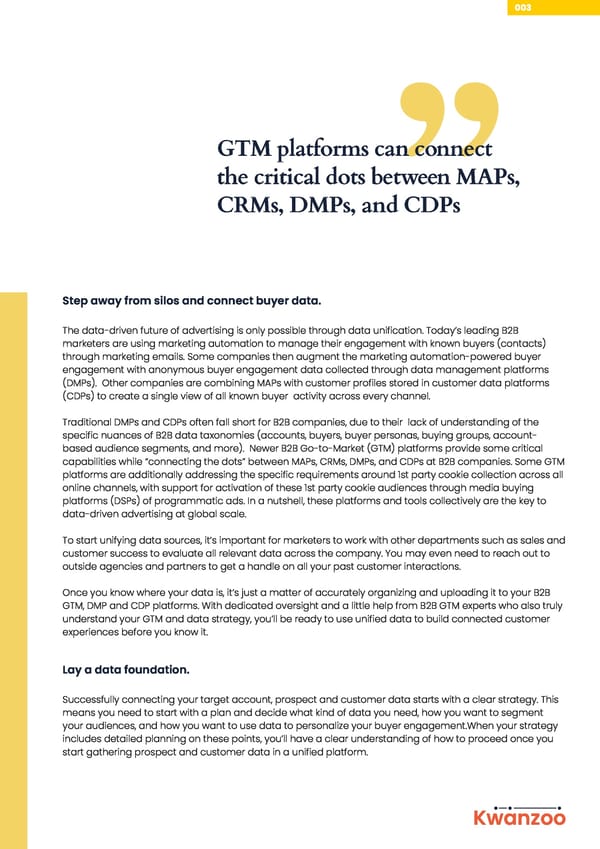003 GGTTMM ppllaattffoorrmmss ccaann ccoonnnneecctt tthhee ccrriittiiccaall ddoottss bbeettwweeeenn MMAAPPss,, CCRRMMss,, DDMMPPss,, aanndd CCDDPPss ” Step away from silos and connect buyer data. The data-driven future of advertising is only possible through data unification. Today’s leading B2B marketers are using marketing automation to manage their engagement with known buyers (contacts) through marketing emails. Some companies then augment the marketing automation-powered buyer engagement with anonymous buyer engagement data collected through data management platforms (DMPs). Other companies are combining MAPs with customer profiles stored in customer data platforms (CDPs) to create a single view of all known buyer activity across every channel. Traditional DMPs and CDPs often fall short for B2B companies, due to their lack of understanding of the specific nuances of B2B data taxonomies (accounts, buyers, buyer personas, buying groups, account- based audience segments, and more). Newer B2B Go-to-Market (GTM) platforms provide some critical capabilities while “connecting the dots” between MAPs, CRMs, DMPs, and CDPs at B2B companies. Some GTM platforms are additionally addressing the specific requirements around 1st party cookie collection across all online channels, with support for activation of these 1st party cookie audiences through media buying platforms (DSPs) of programmatic ads. In a nutshell, these platforms and tools collectively are the key to data-driven advertising at global scale. To start unifying data sources, it’s important for marketers to work with other departments such as sales and customer success to evaluate all relevant data across the company. You may even need to reach out to outside agencies and partners to get a handle on all your past customer interactions. Once you know where your data is, it’s just a matter of accurately organizing and uploading it to your B2B GTM, DMP and CDP platforms. With dedicated oversight and a little help from B2B GTM experts who also truly understand your GTM and data strategy, you’ll be ready to use unified data to build connected customer experiences before you know it. Lay a data foundation. Successfully connecting your target account, prospect and customer data starts with a clear strategy. This means you need to start with a plan and decide what kind of data you need, how you want to segment your audiences, and how you want to use data to personalize your buyer engagement.When your strategy includes detailed planning on these points, you’ll have a clear understanding of how to proceed once you start gathering prospect and customer data in a unified platform. Kwanzoo
 4. Data Driven Advertising Page 3 Page 5
4. Data Driven Advertising Page 3 Page 5